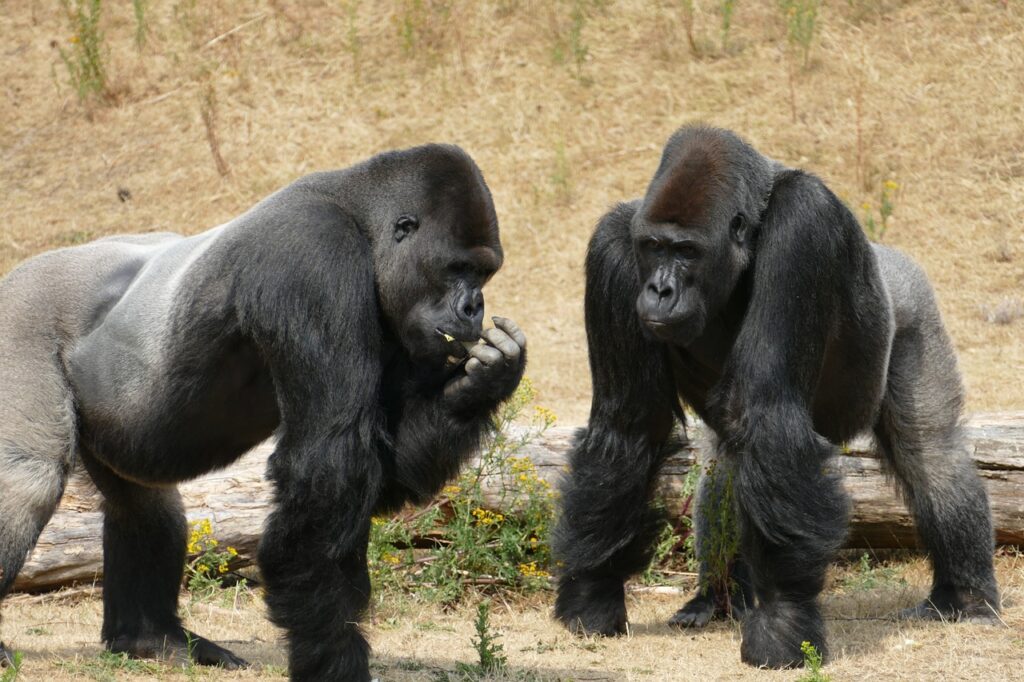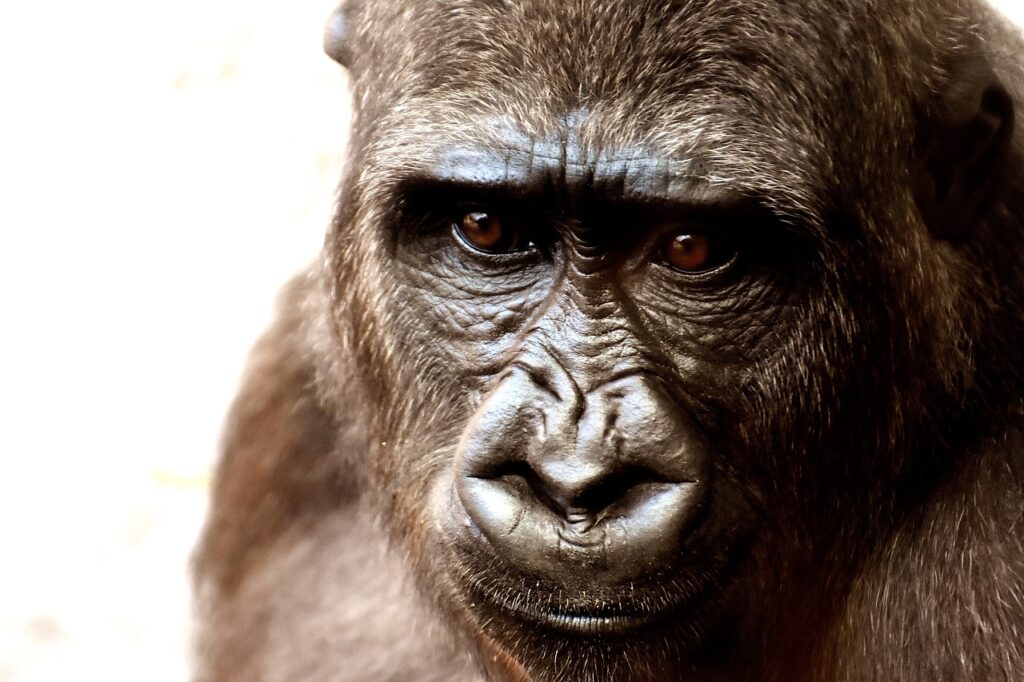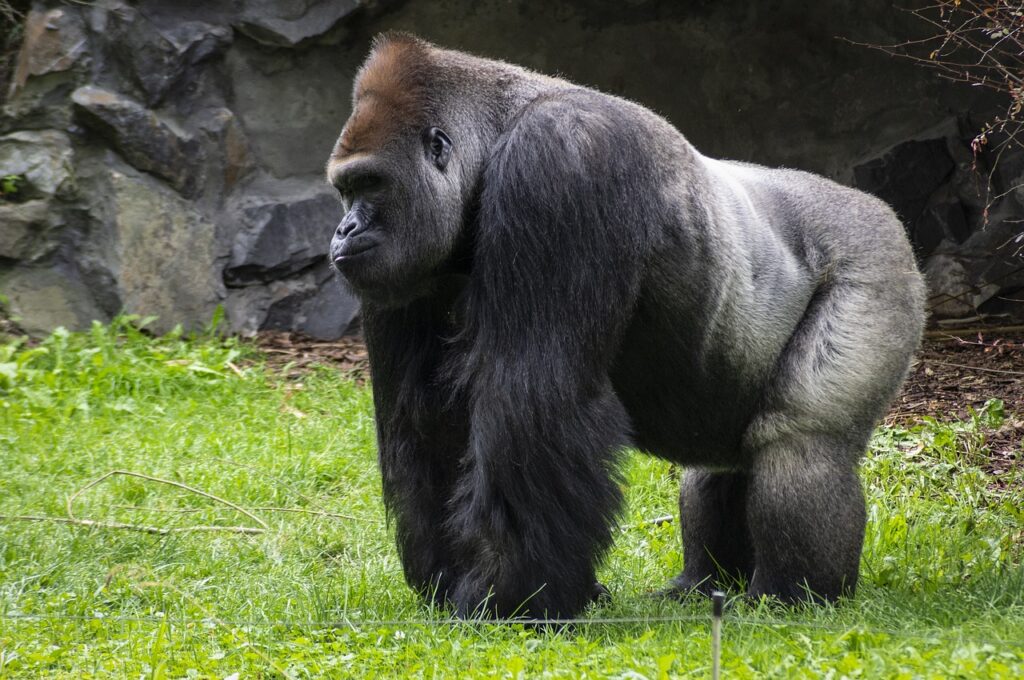When you think of the jungle, what comes to mind? For many, it’s the powerful and majestic gorilla. As one of our closest relatives in the animal kingdom, these gentle giants capture our imagination with their strength, intelligence, and complex social behaviours. Today, we’re diving deep into the world of gorillas to uncover what makes them so fascinating, and why they deserve our protection.
What Are Gorillas?
Gorillas are the largest living primates, belonging to the genus Gorilla. They’re divided into two species: the eastern gorilla (Gorilla beringei) and the western gorilla (Gorilla gorilla). Each species has two subspecies, making a total of four subspecies. Despite their fearsome appearance, gorillas are herbivores and spend their days foraging, resting, and socialising within their groups.
Quick Facts About Gorillas
Diet: Gorillas primarily eat leaves, stems, fruit, and bamboo shoots.
Weight: Adult males can weigh between 300 to 500 pounds, while females are smaller at around 150 to 250 pounds.
Lifespan: In the wild, gorillas typically live for 35-40 years.
Habitat: Gorillas inhabit tropical forests across Africa, with eastern gorillas favouring mountainous regions and western gorillas preferring lowland rainforests.

The Social Life of Gorillas
Gorillas are highly social animals that live in groups called troops or bands. These groups are led by a dominant male known as a silverback, named for the striking silver fur that adorns his back as he matures. A troop typically consists of the silverback, several females, and their offspring.
A Day in the Life of a Gorilla
A typical day for a gorilla revolves around eating, napping, and grooming. They wake up early, spend hours feeding on vegetation, rest during the midday heat, and then resume foraging until evening. Grooming is a critical bonding activity that strengthens social ties within the group.
Communication and Intelligence
Gorillas are incredibly intelligent and use a variety of vocalisations, facial expressions, and gestures to communicate. They’ve even been observed making tools, such as using sticks to gauge water depth or fashioning makeshift ladders. Famous gorillas like Koko, who mastered sign language, have demonstrated just how sophisticated their cognitive abilities are.
Where Do Gorillas Live?
Gorillas are native to the forests of central and western Africa. Each species has a specific range:
- Eastern Gorillas: Found in the Democratic Republic of Congo, Rwanda, and Uganda.
- Western Gorillas: Inhabiting Cameroon, Gabon, and other countries in western Africa.
Their habitats range from lush lowland rainforests to cloud-draped mountain regions. However, these habitats are under constant threat from deforestation, mining, and human encroachment.
Why Are Gorillas Endangered?
All gorilla species are listed as endangered or critically endangered. The main threats include:
- Habitat Loss: Logging, agriculture, and infrastructure projects are destroying the forests gorillas call home.
- Poaching: Despite protective laws, gorillas are often hunted for bushmeat or captured for the illegal pet trade.
- Disease: Gorillas are susceptible to human diseases, including the Ebola virus, which has devastated some populations.
- Climate Change: Shifting weather patterns and habitat fragmentation are impacting their food sources and living conditions.

Conservation Efforts
Fortunately, numerous organisations are working tirelessly to save gorillas. Conservation initiatives include:
- Protected Areas: National parks like Volcanoes National Park in Rwanda and Virunga National Park in Congo provide safe havens.
- Community Engagement: Educating local communities about gorilla conservation and offering alternative livelihoods to reduce poaching.
- Eco-tourism: Gorilla trekking has become a vital source of funding for conservation efforts, allowing tourists to witness these animals in their natural habitat while supporting local economies.
How You Can Help
Want to make a difference? Here are some practical steps:
- Support Conservation Groups: Donate to organisations like the Dian Fossey Gorilla Fund or WWF.
- Eco-Friendly Choices: Reduce your consumption of products linked to deforestation, such as palm oil.
- Spread Awareness: Share information about gorillas and their plight to inspire others to take action.
Fun Gorilla Facts
Let’s lighten things up with some fun facts about these fascinating creatures:
- Gorillas share about 98% of their DNA with humans.
- Despite their size, gorillas are mostly vegetarians, with termites and ants being the occasional exception.
- A gorilla’s strength is estimated to be ten times greater than the average human’s.
- Baby gorillas are adorably playful, much like human toddlers.
Gorillas in Pop Culture
Gorillas have captured the human imagination for decades, often appearing in books, movies, and documentaries. Iconic films like King Kong have cemented the image of gorillas as powerful yet misunderstood creatures. Documentaries such as Virunga and Gorillas in the Mist have shed light on their plight, inspiring global audiences to take action. Even video games and toys feature gorillas, making them a beloved symbol of strength and connection to nature.
Gorilla Trekking: A Bucket List Experience
For many wildlife enthusiasts, gorilla trekking is a once-in-a-lifetime opportunity. Trekking through dense forests to encounter a troop in the wild is an awe-inspiring experience. Countries like Rwanda and Uganda offer guided treks, ensuring the safety of both humans and gorillas. The funds raised from permits directly contribute to conservation efforts, making eco-tourism a win-win for both the species and the local communities.
The Role of Gorillas in Ecosystems
Gorillas are often referred to as “gardeners of the forest” because of their vital role in seed dispersal. As they travel through their habitats, they consume fruits and excrete the seeds, helping to regenerate plant growth. This natural process ensures the health and diversity of the forest, benefiting countless other species. Without gorillas, the balance of these ecosystems could be disrupted, leading to a cascade of negative effects.
The Connection Between Gorillas and Humans
It’s no wonder gorillas feel so familiar – they’re our genetic cousins. Observing their family dynamics, emotions, and problem-solving skills often reminds us of our shared ancestry. This connection is why many people feel a deep sense of responsibility to protect them. By saving gorillas, we’re also safeguarding a piece of our own evolutionary history.

Gorillas and Modern Research
Researchers are continuously uncovering new insights into the lives of gorillas. Recent studies have highlighted their ability to understand numerical concepts, make deliberate decisions, and even exhibit a sense of humour. For instance, wild gorillas have been observed using vines to play games, showcasing their playful nature. By studying gorillas, scientists also gain a better understanding of early human behaviour, helping to unravel the story of our evolution.
Gorilla-Friendly Initiatives in Business
A growing number of businesses are recognising the importance of gorilla conservation and are incorporating it into their operations. For example, eco-friendly tourism companies provide guided tours with minimal environmental impact. Some tech companies are also sourcing conflict-free minerals to reduce habitat destruction linked to mining. Supporting such businesses ensures that your purchases align with your values.
Global Campaigns for Gorilla Awareness
World Gorilla Day, celebrated on September 24th, has become a global movement to highlight the importance of protecting these magnificent creatures. From virtual events to on-the-ground activities in Africa, the day is an opportunity to unite people worldwide in the fight for gorilla conservation. It’s a chance for individuals, organisations, and governments to reaffirm their commitment to safeguarding gorilla populations.
Educational Programs for the Next Generation
Teaching children about gorillas and their ecosystems fosters a sense of responsibility from a young age. Many zoos and wildlife organisations offer educational programs where kids can learn about gorillas through interactive activities. These programs inspire future generations to become stewards of the environment and advocates for endangered species.
Why Every Effort Counts
The challenges facing gorillas are daunting, but every effort matters. From global policies to individual actions, it’s crucial to keep the momentum going. Grassroots campaigns, scientific research, and international cooperation all play a part in ensuring gorillas have a future.
Closing Thoughts
Gorillas remind us of the beauty and complexity of the natural world. Their plight serves as a powerful call to action: to protect not just them but the countless species that share their habitat. Let’s ensure that future generations can marvel at these gentle giants in the wild, where they belong.
Bring the wild home with the Terra by Battat Gorilla Family Set – perfect for kids who love exploring the jungle! See or buy gorillas toys here!
